fuel type FIAT 500L LIVING 2014 2.G Owners Manual
[x] Cancel search | Manufacturer: FIAT, Model Year: 2014, Model line: 500L LIVING, Model: FIAT 500L LIVING 2014 2.GPages: 420, PDF Size: 9.77 MB
Page 8 of 420
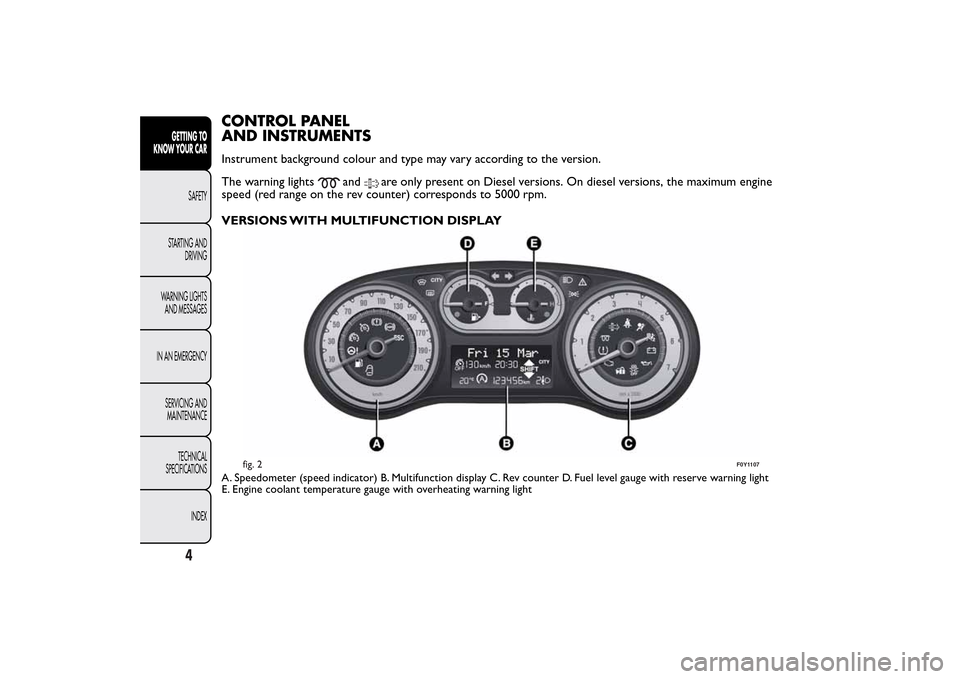
CONTROL PANEL
AND INSTRUMENTSInstrument background colour and type may vary according to the version.
The warning lights
and
are only present on Diesel versions. On diesel versions, the maximum engine
speed (red range on the rev counter) corresponds to 5000 rpm.
VERSIONS WITH MULTIFUNCTION DISPLAY
A. Speedometer (speed indicator) B. Multifunction display C. Rev counter D. Fuel level gauge with reserve warning light
E. Engine coolant temperature gauge with overheating warning light
fig. 2
F0Y1107
4
GETTING TO
KNOW YOUR CAR
SAFETY
STARTING AND
DRIVING
WARNING LIGHTS
AND MESSAGES
IN AN EMERGENCY
SERVICING AND
MAINTENANCE
TECHNICAL
SPECIFICATIONS
INDEX
Page 25 of 420
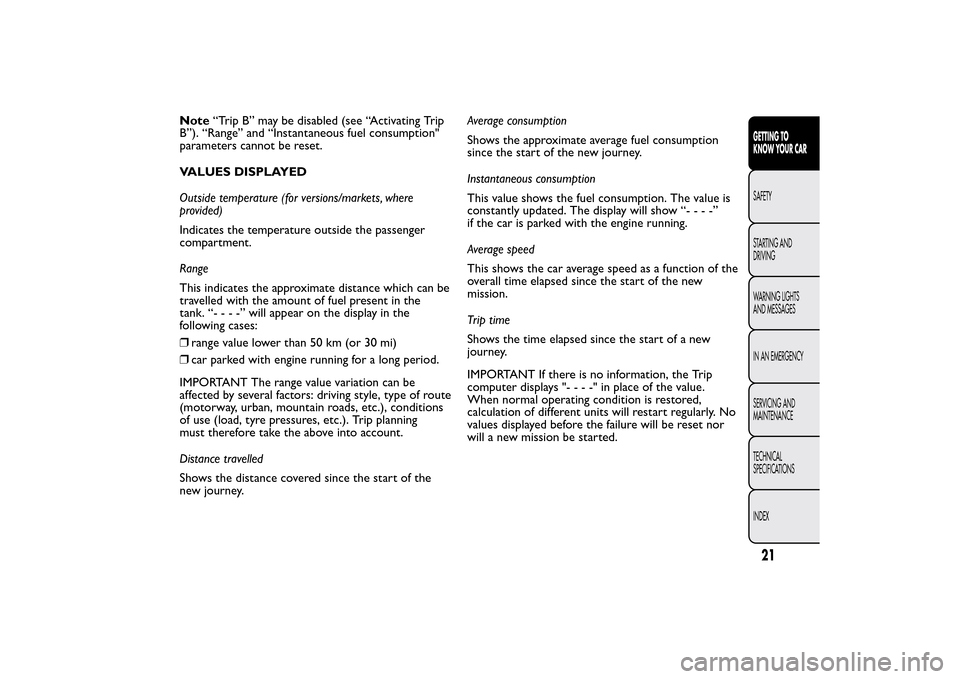
Note“Trip B” may be disabled (see “Activating Trip
B”). “Range” and “Instantaneous fuel consumption"
parameters cannot be reset.
VALUES DISPLAYED
Outside temperature (for versions/markets, where
provided)
Indicates the temperature outside the passenger
compartment.
Range
This indicates the approximate distance which can be
travelled with the amount of fuel present in the
tank.“----”will appear on the display in the
following cases:
❒range value lower than 50 km (or 30 mi)
❒car parked with engine running for a long period.
IMPORTANT The range value variation can be
affected by several factors: driving style, type of route
(motorway, urban, mountain roads, etc.), conditions
of use (load, tyre pressures, etc.). Trip planning
must therefore take the above into account.
Distance travelled
Shows the distance covered since the start of the
new journey.Average consumption
Shows the approximate average fuel consumption
since the start of the new journey.
Instantaneous consumption
This value shows the fuel consumption. The value is
constantly updated. The display will show “----”
if the car is parked with the engine running.
Average speed
This shows the car average speed as a function of the
overall time elapsed since the start of the new
mission.
Tr i p t i me
Shows the time elapsed since the start of a new
journey.
IMPORTANT If there is no information, the Trip
computer displays "----"inplaceofthevalue.
When normal operating condition is restored,
calculation of different units will restart regularly. No
values displayed before the failure will be reset nor
will a new mission be started.
21GETTING TO
KNOW YOUR CARSAFETY
STARTING AND
DRIVING
WARNING LIGHTS
AND MESSAGES
IN AN EMERGENCY
SERVICING AND
MAINTENANCE
TECHNICAL
SPECIFICATIONS
INDEX
Page 123 of 420
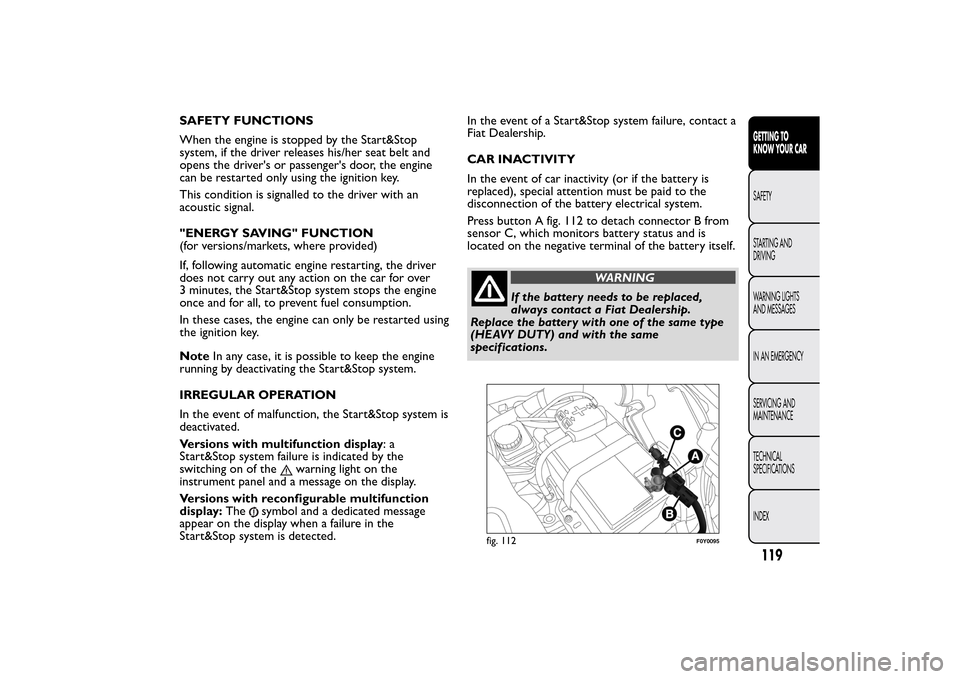
SAFETY FUNCTIONS
When the engine is stopped by the Start&Stop
system, if the driver releases his/her seat belt and
opens the driver's or passenger's door, the engine
can be restarted only using the ignition key.
This condition is signalled to the driver with an
acoustic signal.
"ENERGY SAVING" FUNCTION
(for versions/markets, where provided)
If, following automatic engine restarting, the driver
does not carry out any action on the car for over
3 minutes, the Start&Stop system stops the engine
once and for all, to prevent fuel consumption.
In these cases, the engine can only be restarted using
the ignition key.
NoteIn any case, it is possible to keep the engine
running by deactivating the Start&Stop system.
IRREGULAR OPERATION
In the event of malfunction, the Start&Stop system is
deactivated.
Versions with multifunction display:a
Start&Stop system failure is indicated by the
switching on of the
warning light on the
instrument panel and a message on the display.
Versions with reconfigurable multifunction
display:The
symbol and a dedicated message
appear on the display when a failure in the
Start&Stop system is detected.In the event of a Start&Stop system failure, contact a
Fiat Dealership.
CAR INACTIVITY
In the event of car inactivity (or if the battery is
replaced), special attention must be paid to the
disconnection of the battery electrical system.
Press button A fig. 112 to detach connector B from
sensor C, which monitors battery status and is
located on the negative terminal of the battery itself.
WARNING
If the battery needs to be replaced,
always contact a Fiat Dealership.
Replace the battery with one of the same type
(HEAVY DUTY) and with the same
specifications.
fig. 112
F0Y0095
119GETTING TO
KNOW YOUR CARSAFETY
STARTING AND
DRIVING
WARNING LIGHTS
AND MESSAGES
IN AN EMERGENCY
SERVICING AND
MAINTENANCE
TECHNICAL
SPECIFICATIONS
INDEX
Page 140 of 420
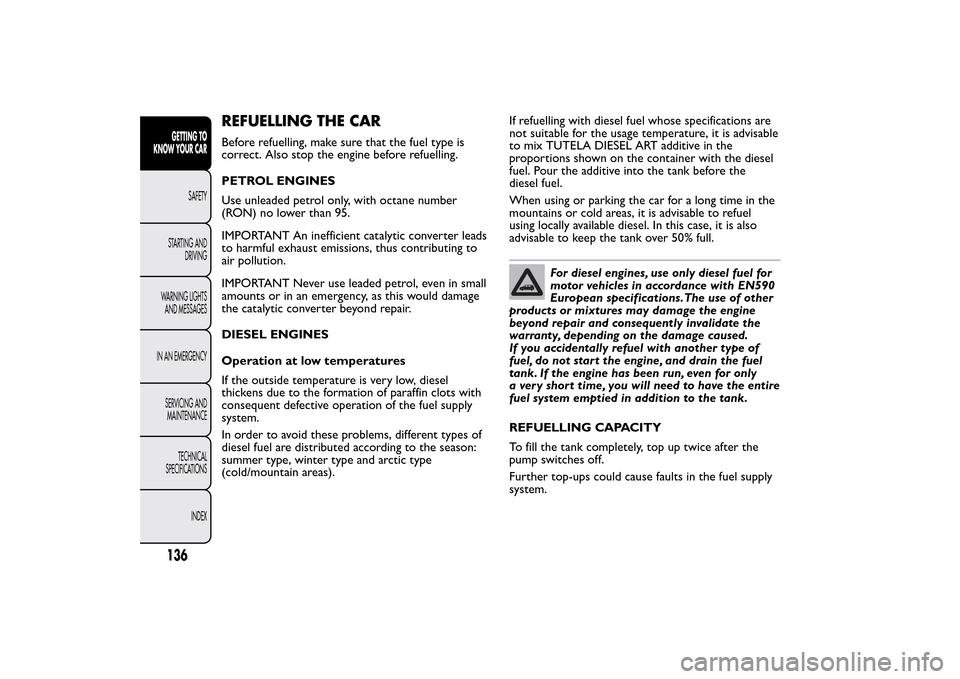
REFUELLING THE CARBefore refuelling, make sure that the fuel type is
correct. Also stop the engine before refuelling.
PETROL ENGINES
Use unleaded petrol only, with octane number
(RON) no lower than 95.
IMPORTANT An inefficient catalytic converter leads
to harmful exhaust emissions, thus contributing to
air pollution.
IMPORTANT Never use leaded petrol, even in small
amounts or in an emergency, as this would damage
the catalytic converter beyond repair.
DIESEL ENGINES
Operation at low temperatures
If the outside temperature is very low, diesel
thickens due to the formation of paraffin clots with
consequent defective operation of the fuel supply
system.
In order to avoid these problems, different types of
diesel fuel are distributed according to the season:
summer type, winter type and arctic type
(cold/mountain areas).If refuelling with diesel fuel whose specifications are
not suitable for the usage temperature, it is advisable
to mix TUTELA DIESEL ART additive in the
proportions shown on the container with the diesel
fuel. Pour the additive into the tank before the
diesel fuel.
When using or parking the car for a long time in the
mountains or cold areas, it is advisable to refuel
using locally available diesel. In this case, it is also
advisable to keep the tank over 50% full.
For diesel engines, use only diesel fuel for
motor vehicles in accordance with EN590
European specifications.The use of other
products or mixtures may damage the engine
beyond repair and consequently invalidate the
warranty, depending on the damage caused.
If you accidentally refuel with another type of
fuel, do not start the engine, and drain the fuel
tank. If the engine has been run, even for only
a ver y shor t time, you will need to have the entire
fuel system emptied in addition to the tank.
REFUELLING CAPACITY
To fill the tank completely, top up twice after the
pump switches off.
Further top-ups could cause faults in the fuel supply
system.
136GETTING TO
KNOW YOUR CAR
SAFETY
STARTING AND
DRIVING
WARNING LIGHTS
AND MESSAGES
IN AN EMERGENCY
SERVICING AND
MAINTENANCE
TECHNICAL
SPECIFICATIONS
INDEX
Page 141 of 420
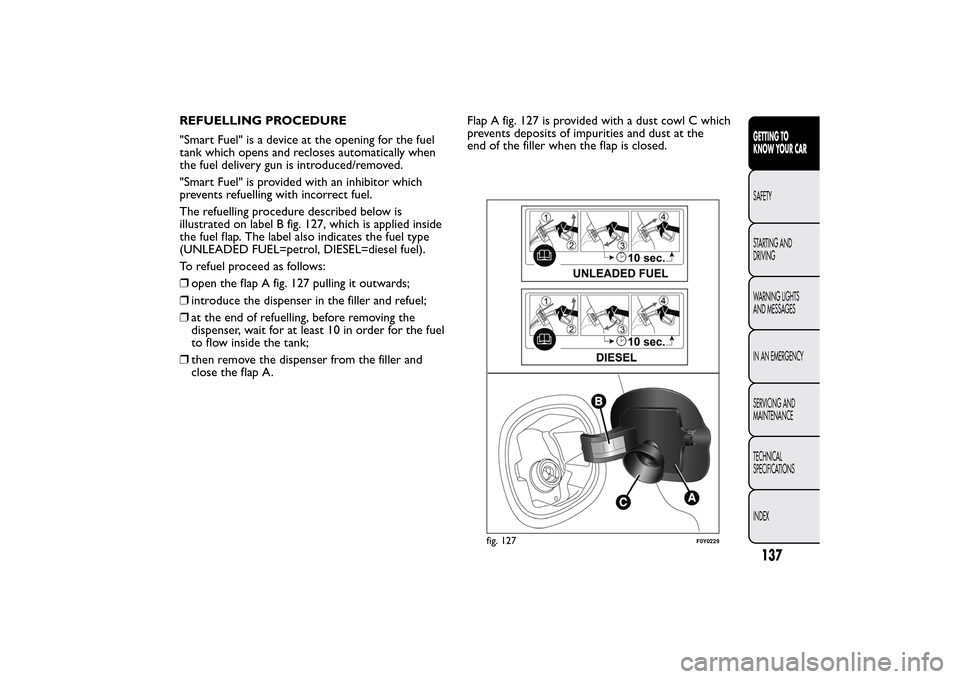
REFUELLING PROCEDURE
"Smart Fuel" is a device at the opening for the fuel
tank which opens and recloses automatically when
the fuel delivery gun is introduced/removed.
"Smart Fuel" is provided with an inhibitor which
prevents refuelling with incorrect fuel.
The refuelling procedure described below is
illustrated on label B fig. 127, which is applied inside
the fuel flap. The label also indicates the fuel type
(UNLEADED FUEL=petrol, DIESEL=diesel fuel).
To refuel proceed as follows:
❒open the flap A fig. 127 pulling it outwards;
❒introduce the dispenser in the filler and refuel;
❒at the end of refuelling, before removing the
dispenser, wait for at least 10 in order for the fuel
to flow inside the tank;
❒then remove the dispenser from the filler and
close the flap A.Flap A fig. 127 is provided with a dust cowl C which
prevents deposits of impurities and dust at the
end of the filler when the flap is closed.
fig. 127
F0Y0229
137GETTING TO
KNOW YOUR CARSAFETY
STARTING AND
DRIVING
WARNING LIGHTS
AND MESSAGES
IN AN EMERGENCY
SERVICING AND
MAINTENANCE
TECHNICAL
SPECIFICATIONS
INDEX
Page 144 of 420

PROTECTING THE ENVIRONMENTThe following devices are used for reducing petrol
fuel engine emissions: catalytic converter, oxygen
sensors and evaporation control system
Do not let the engine run, even for a test, with one
or more spark plugs disconnected.
The following devices are used for reducing diesel
fuel engine emissions: oxidising catalytic converter,
exhaust gas recirculation system (EGR) and
particulate filter (DPF).
DIESEL PARTICULATE FILTER
(for versions/markets, where provided)
The Diesel Particulate Filter is a mechanical filter,
integral with the exhaust system, that physically traps
particulates present in the exhaust gases of Diesel
engines.
The diesel particulate filter is needed to eliminate
almost all particulates in compliance with current/
future legislation.
During normal use of the vehicle, the engine control
unit records a set of data (e.g. travel time, type of
route, temperatures, etc.) and it will then calculate
how much particulate has been trapped by the filter.
Since this filter physically traps particulate, it should
be regenerated (cleaned) at regular intervals by
burning the carbon particles.The regeneration procedure is controlled
automatically by the engine management control unit
according to the filter conditions and car use
conditions.
During the regeneration there may be a limited
increase in the engine idle speed, fan activation, a
limited increase in fumes and high temperatures at
the exhaust.
These are not faults; they do not impair normal car
performance or damage the environment. If the
dedicated message is displayed, see contents of
"Warning lights and messages" chapter.
WARNING
The catalytic converter and particulate
filter (DPF) reach very high
temperatures during operation.Therefore, do
not park the car on flammable materials (grass,
dry leaves, pine needles etc .) to avoid the risk
of fire.
140GETTING TO
KNOW YOUR CAR
SAFETY
STARTING AND
DRIVING
WARNING LIGHTS
AND MESSAGES
IN AN EMERGENCY
SERVICING AND
MAINTENANCE
TECHNICAL
SPECIFICATIONS
INDEX
Page 179 of 420

CONDITIONS OF USE
Cold starting
Short distances and frequent cold start-ups will
prevent the engine from reaching optimal running
temperature.
Consequently, both consumption (from +15 to +30%
on urban cycle ) and emissions will increase.
Traffic and road conditions
Rather high fuel consumption is caused by heavy
traffic, for instance when travelling in a queue with
frequent use of low gears or in large towns with
many traffic lights.
Mountain and rough roads also have a negative effect
on fuel consumption.
Stops in traffic
During prolonged stops (e.g. level crossings) the
engine should be switched off.
TOWING TRAILERSIMPORTANT NOTES
For towing caravans or trailers the car must be fitted
with a type-approved tow hook and an adequate
electrical system. Installation must be carried out by
a specialist.
Install any specific and/or additional rear view mirrors
as specified by the Highway Code.
Remember that when towing a trailer, steep hills are
harder to climb, braking distances increase and
overtaking takes longer depending on the overall
weight of the trail.
Engage a low gear when driving downhill, rather than
constantly using the brake.
The weight of the trailer on the car's tow hook will
reduce the load capacity of the car by the same
amount. To make sure that the maximum towable
weight is not exceeded (given in the car registration
document) account should be taken of the fully
laden trailer, including accessories and luggage.
Respect the speed limits specific to each country for
vehicles towing trailers. In any case, the top speed
must not exceed 100 km/h.
175GETTING TO KNOW
YOUR CAR
SAFETYSTARTING AND
DRIVINGWARNING LIGHTS
AND MESSAGES
IN AN EMERGENCY
SERVICING AND
MAINTENANCE
TECHNICAL
SPECIFICATIONS
INDEX
Page 190 of 420

Remember that the deterioration of the engine oil is
accelerated by:
❒mainly town use of the car which makes the DPF
regeneration process more frequent;
❒use of the car for short drives, in which the engine
does not have time to reach its regular operating
temperature;
❒repeated interruption of the regeneration process,
signalled by the DPF warning light coming on.
WARNING
If the warning light switches on, the
deteriorated engine oil must be changed
as soon as possible, and never more than 500
km from the first time that the warning light
switches on. Failure to observe the above may
result in severe damage to the engine and
invalidate the warranty.The activation of this
warning light is not related to the amount of oil
in the engine.Therefore, never top up with oil
when the warning light starts flashing.
HOT ENGINE COOLANT
(red)
Turning the key to the MAR-ON position illuminates
the warning light, but it should switch off after a
few seconds.The warning light switches on (on some versions
together with a message and a symbol on the display)
when the engine is overheated.
If the warning light comes on when driving, proceed
as follows:
❒when driving normally:stop the car, switch off
the engine and check that the water level in the
reservoir is not below the MIN mark. If it is, wait
for the engine to cool down, then slowly and
carefully open the cap, top up with coolant and
check that the level is between the MIN and MAX
marks on the reservoir. Also check visually for
any fluid leaks. If, when restarting, the warning
light comes on again, contact a Fiat Dealership;
❒if the vehicle is used under demanding
conditions(e.g. towing trailers uphill or fully
loaded): slow down and, if the light stays on, stop
the car. Wait for 2 or 3 minutes with the engine
running and slightly accelerated to further favour
the coolant circulation. Then stop the engine.
Check the correct coolant level as described
above. Should the level of fluid be too low, top up
(for the quantity and type of fluid to use, see
the description in the "Refuelling" paragraph in the
"Technical specifications" chapter).
IMPORTANT Over demanding routes, it is advisable
to keep the engine on and slightly accelerated for
a few minutes before switching it off.
186GETTING TO KNOW
YOUR CAR
SAFETY
STARTING AND
DRIVINGWARNING LIGHTS
AND MESSAGESIN AN EMERGENCY
SERVICING AND
MAINTENANCE
TECHNICAL
SPECIFICATIONS
INDEX
Page 292 of 420
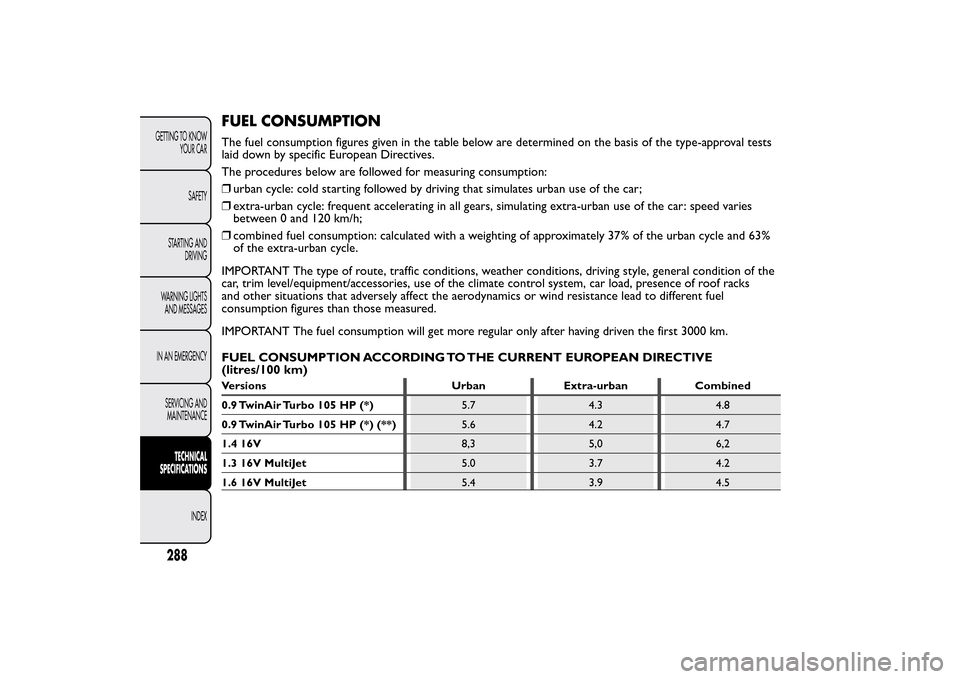
FUEL CONSUMPTIONThe fuel consumption figures given in the table below are determined on the basis of the type-approval tests
laid down by specific European Directives.
The procedures below are followed for measuring consumption:
❒urban cycle: cold starting followed by driving that simulates urban use of the car;
❒extra-urban cycle: frequent accelerating in all gears, simulating extra-urban use of the car: speed varies
between 0 and 120 km/h;
❒combined fuel consumption: calculated with a weighting of approximately 37% of the urban cycle and 63%
of the extra-urban cycle.
IMPORTANT The type of route, traffic conditions, weather conditions, driving style, general condition of the
car, trim level/equipment/accessories, use of the climate control system, car load, presence of roof racks
and other situations that adversely affect the aerodynamics or wind resistance lead to different fuel
consumption figures than those measured.
IMPORTANT The fuel consumption will get more regular only after having driven the first 3000 km.
FUEL CONSUMPTION ACCORDING TO THE CURRENT EUROPEAN DIRECTIVE
(litres/100 km)Versions Urban Extra-urban Combined
0.9 TwinAir Turbo 105 HP (*)5.7 4.3 4.8
0.9 TwinAir Turbo 105 HP (*) (**)5.6 4.2 4.7
1.4 16V8,3 5,0 6,2
1.3 16V MultiJet5.0 3.7 4.2
1.6 16V MultiJet5.4 3.9 4.5
288GETTING TO KNOW
YOUR CAR
SAFETY
STARTING AND
DRIVING
WARNING LIGHTS
AND MESSAGES
IN AN EMERGENCY
SERVICING AND
MAINTENANCE
TECHNICAL
SPECIFICATIONS
INDEX
Page 300 of 420

CONTROL PANEL AND INSTRUMENTSInstrument background colour and type may vary according to the version.
The warning lights
and
are only present on Diesel versions. On diesel versions, the max. rpm (red
range on the revolution counter) corresponds to 5000 rpm.
VERSIONS WITH MULTIFUNCTION DISPLAY
A. Speedometer (speed indicator) B. Multifunction display C. Rev counter D. Fuel level gauge with reserve warning light
E. Engine coolant temperature gauge with overheating warning light
fig. 2
F0Y0183
296
RIGHT HAND DRIVE VERSIONS